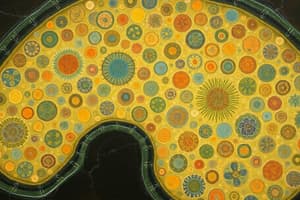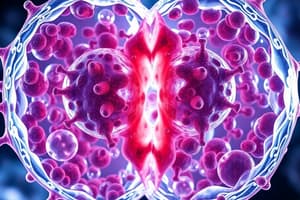Podcast
Questions and Answers
What are the primary building blocks of life?
What are the primary building blocks of life?
Cells
What is the smallest known cell?
What is the smallest known cell?
Mycoplasma gallicepticum
What is the largest known cell?
What is the largest known cell?
Ostrich egg
Rudolf Virchow published evidence that cells are derived from other cells.
Rudolf Virchow published evidence that cells are derived from other cells.
In what year did Robert Hooke first record cells?
In what year did Robert Hooke first record cells?
What does the Latin phrase 'omnis cellula a cellula' mean?
What does the Latin phrase 'omnis cellula a cellula' mean?
Cells contain hereditary information that is not passed during cell division.
Cells contain hereditary information that is not passed during cell division.
What are the chemical elements that normally make up more than 99% of the mass of living cells?
What are the chemical elements that normally make up more than 99% of the mass of living cells?
Who made extensive microscopic observations of plant tissues in 1838?
Who made extensive microscopic observations of plant tissues in 1838?
What is the second tenet of modern cell theory?
What is the second tenet of modern cell theory?
Flashcards are hidden until you start studying
Study Notes
Cells
- Primary building blocks of life, varying in shapes and sizes.
- Smallest cell: Mycoplasma gallicepticum (0.3 µm).
- Largest cell: Ostrich egg (6 inches in diameter).
Cell Theory
- All organisms consist of cells; cells are the basic structural and functional units of life.
Key Contributors to Cell Theory
-
Robert Hooke
- First to record cells in 1665 while examining cork through an improved microscope.
- Noted box-like structures, leading to the identification of cell walls.
-
Matthias Schleiden
- German botanist who studied plant tissues in 1838.
- Proposed that all plants are composed of cells.
-
Theodor Schwann
- German physiologist who made similar observations in animal tissues in 1839.
- Suggested that animals, like plants, are also made up of cells.
-
Rudolf Virchow
- Prominent pathologist who provided evidence in 1852 that cells originate from other cells through division.
- Popularized the phrase “omnis cellula a cellula” (all cells arise from cells) in his 1855 editorial, "Cellular Pathology."
Profound Postulates of Cell Theory
- Cells contain hereditary information that is passed on during cell division.
- Life's processes depend on cells' ability to store, retrieve, and translate genetic information essential for maintaining organisms.
- Genetic instructions are coded in genes, affecting species characteristics and individual traits.
Chemical Composition of Cells
- All cells share a similar chemical composition, primarily composed of hydrogen, oxygen, nitrogen, carbon, phosphorus, and sulfur, which constitute over 99% of living cells' mass.
- These elements are crucial for synthesizing organic biomolecules necessary for life.
Studying That Suits You
Use AI to generate personalized quizzes and flashcards to suit your learning preferences.




